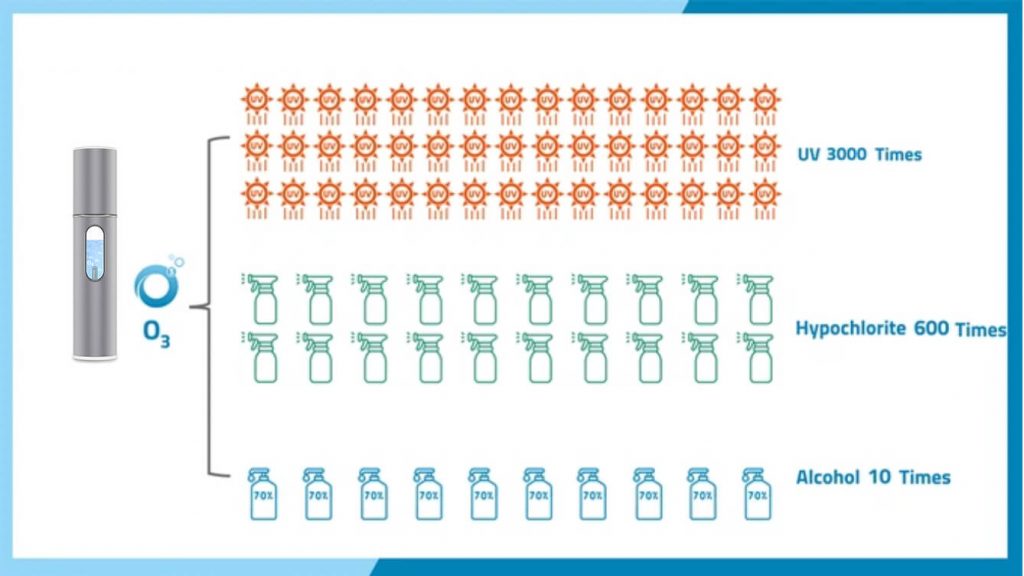Ozone water VS medical alcohol you need to know

In the hospital environment, medical staff ‘ hands have to perform a range of non-invasive or invasive operations, and they directly or indirectly come into contact with contaminants, such as the patient’s skin, body fluids, blood or other objects. Therefore, the medical staff’s hands are one of the common transmission vectors of pathogens. Hand hygiene and sanitizing is mainly a measure taken to reduce the risk of cross-infection in all aspects of the work of medical staff, and it is an important method for the prevention and control of hospital infections.
A study in the “Chinese Journal of Disinfection” pointed out that the use of a rapid hand disinfectant (containing chlorhexidine acetate 3000mg/L and 75% ethanol) alone for hand hygiene disinfection had the hygienic pass rate of only 82.47%. And quick hand disinfectant is indeed one of the most used hand hygiene disinfection methods in major hospitals. However, the rapid hand hygiene disinfectant also has its shortcomings. Because it contains a higher concentration of ethanol, the hand hygiene disinfectant is relatively irritating. Frequent use for a long time can cause the occurrence of nurse hand dermatitis. In some studies, the probability of medical staff developing occupational hand dermatitis is about 30%, and occasional allergic reactions occur too.
In addition, studies have shown there is a certain correlation between the resistance of bacteria to disinfectants and the resistance to antibiotics. Therefore, it is recommended to replace disinfectants in cycles to reduce the abuse of disinfectants and prevent pathogens caused by improper use from producing disinfectant resistance.
Researchers from Norway published a study in the” Journal of Hospital Infection,” comparing the ability of ozonized running water and alcohol disinfectant to disinfect hands contaminated by E. coli.

Researchers conducted a cross-over study involving 30 nursing students. The test procedure for this study is based on European standards amended by EN1500:2013, and it specifies a method that simulates actual conditions to determine the effect of products used for hand hygiene and sanitizing to reduce artificial pollution and the number of microorganisms after use by volunteers.
Before the start of the study, none of the 30 nursing students had any hand dermatitis. On the first day, 30 students were randomly divided into two groups with 15 students in each group. One group of students used 0.8 ppm ozone water and the other group used 4.0 ppm ozone water. After six days, the students were asked to start using ethanol hand sanitizer. According to the recommendations of standard procedures, the test organism is a non-pathogenic E. coli (usually used as a reference strain in microbiological studies).
The test subjects first washed their hands with soap and warm water for 1 minute, dried their hands with a paper towel, and then put their hands in a glass container containing a bacterial solution for 5 seconds. After drying your hands, they immediately rubbed their fingertips on the petri dish, using a separate petri dish for each hand. Without further delay, they use ozone-treated water or ethanol hand sanitizer (3mL) to wash hands for 30 seconds. After cleaning, they tried their fingertips and rub them on a new Petri dish.
It was found that 8 students (27%) had different degrees of skin problems related to hand washing and disinfection. 20% of nursing students had the adverse effects of using alcohol for disinfection (burning/drying), and there was no adverse reaction when using ozone to treat water. Most people (77%) expressed their preference for ozonized water disinfection.
All contaminated hands before disinfection showed cfu>30000/mL. The average number of bacteria (cfu/mL) in the hands after disinfection with ozone-treated water was 1017, and after disinfection with alcohol was 2337. The medians were 500 and 250 respectively (no significant difference).

The study showed that the ability of ozone-treated water to disinfect E. coli is similar to 85% alcohol. The concentration of ozone gas in the air around the subjects was low, and no adverse skin reactions occurred after the ozone-treated water disinfected hands. The ozone hand disinfection method is simple, cheap and has no residue, and ozone is also safe when dissolved in water.
Researchers believe that it is feasible to use ozone water to replace traditional liquid hand alcohol disinfectants. At the same time, it is observed 0.8ppm ozone-treated water is better than 4.0ppm ozone-treated water.
In addition, the researchers pointed out that since water and alcohol disinfectant have the same antibacterial effect after ozone disinfection, it can be used in hand disinfection applications, especially for medical staff with hand and skin problems. Very beneficial, safe, and healthy.

